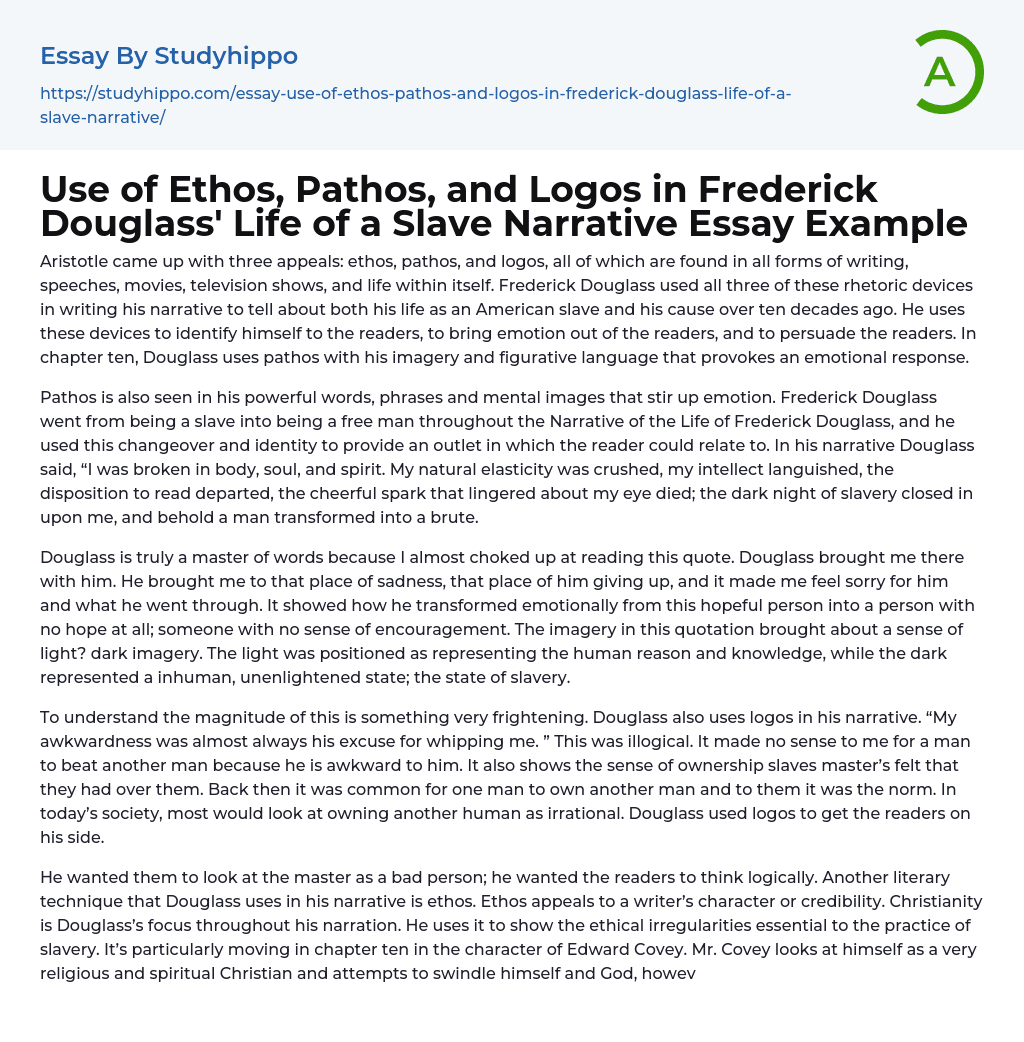

Use of Ethos, Pathos, and Logos in Frederick Douglass’ Life of a Slave Narrative Essay Example
Aristotle came up with three appeals: ethos, pathos, and logos, all of which are found in all forms of writing, speeches, movies, television shows, and life within itself. Frederick Douglass used all three of these rhetoric devices in writing his narrative to tell about both his life as an American slave and his cause over ten decades ago. He uses these devices to identify himself to the readers, to bring emotion out of the readers, and to persuade the readers. In chapter ten, Douglass uses pathos with his imagery and figurative language that provokes an emotional response.
Pathos is also seen in his powerful words, phrases and mental images that stir up emotion. Frederick Douglass went from being a slave into being a free man throughout the Narrative
...of the Life of Frederick Douglass, and he used this changeover and identity to provide an outlet in which the reader could relate to. In his narrative Douglass said, “I was broken in body, soul, and spirit. My natural elasticity was crushed, my intellect languished, the disposition to read departed, the cheerful spark that lingered about my eye died; the dark night of slavery closed in upon me, and behold a man transformed into a brute.
Douglass is truly a master of words because I almost choked up at reading this quote. Douglass brought me there with him. He brought me to that place of sadness, that place of him giving up, and it made me feel sorry for him and what he went through. It showed how he transformed emotionally from this hopeful person into a person with no hope at all
someone with no sense of encouragement. The imagery in this quotation brought about a sense of light? dark imagery. The light was positioned as representing the human reason and knowledge, while the dark represented a inhuman, unenlightened state; the state of slavery.
To understand the magnitude of this is something very frightening. Douglass also uses logos in his narrative. “My awkwardness was almost always his excuse for whipping me. ” This was illogical. It made no sense to me for a man to beat another man because he is awkward to him. It also shows the sense of ownership slaves master’s felt that they had over them. Back then it was common for one man to own another man and to them it was the norm. In today’s society, most would look at owning another human as irrational. Douglass used logos to get the readers on his side.
He wanted them to look at the master as a bad person; he wanted the readers to think logically. Another literary technique that Douglass uses in his narrative is ethos. Ethos appeals to a writer’s character or credibility. Christianity is Douglass’s focus throughout his narration. He uses it to show the ethical irregularities essential to the practice of slavery. It’s particularly moving in chapter ten in the character of Edward Covey. Mr. Covey looks at himself as a very religious and spiritual Christian and attempts to swindle himself and God, however his evil actions expose him to be nothing more than a two-faced sinner.
Douglass stated that Mr. Covey’s “…life was devoted to planning and perpetrating the grossest deceptions. Every thing he possessed in
the shape of learning or religion, he made conform to his disposition to deceive. ” This linked the readers by portraying an extremely clear sample of the ethical paradox of being a Christian and a slave owner. Without pathos, ethos, and logos, this narrative would be simply words on paper. Frederick Douglass did an amazing job in writing this autobiography of his life. It really showed his transformations from an uneducated young slave to an articulate orator.
- Acceptance essays
- Age Of Enlightenment essays
- Child Observation essays
- Confucianism essays
- Conscience essays
- Critical Reflection essays
- Destiny essays
- Determinism essays
- Empiricism essays
- Environmentalism essays
- Epistemology essays
- Ethics essays
- Ethos essays
- Existence essays
- Existentialism essays
- Fate essays
- Free Will essays
- Functionalism essays
- Future essays
- Good And Evil essays
- Human Nature essays
- Individualism essays
- Meaning Of Life essays
- Metaphysics essays
- Natural Law essays
- Personal Philosophy essays
- Philosophers essays
- Philosophy Of Life essays
- Political Philosophy essays
- Pragmatism essays
- Reality essays
- Relativism essays
- Teaching Philosophy essays
- Time essays
- Transcendentalism essays
- Truth essays
- Utilitarianism essays
- Ben jonson essays
- Billy elliot essays
- Dred Scott essays
- Frederick Douglass essays
- Geert Hofstede essays
- George Eliot essays
- Ginevra King essays
- Harriet Tubman essays
- John Keats essays
- John Proctor essays
- Joseph Stalin essays
- Mahatma Gandhi essays
- Napoleon essays



